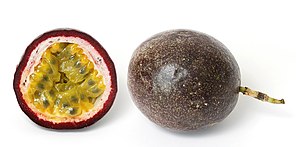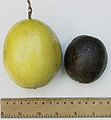Passiflora edulis: Difference between revisions
Tpbradbury (talk | contribs) m →References: modernise to see if toolserver still picks-up as error |
|||
| Line 36: | Line 36: | ||
[[Image:Passionfruitjuice2.jpg|thumb|A glass of passion fruit juice]][[File:Passion fruit wine at Morad Winery in Israel.jpg|thumb|Wine, or 'sicar', made from passion fruit at a winery in [[Israel]].]] |
[[Image:Passionfruitjuice2.jpg|thumb|A glass of passion fruit juice]][[File:Passion fruit wine at Morad Winery in Israel.jpg|thumb|Wine, or 'sicar', made from passion fruit at a winery in [[Israel]].]] |
||
*In [[Australia]], it is available commercially fresh and canned. In addition to being added to fruit salads, passion fruit is commonly used in [[desserts]], such as the topping for the [[Pavlova (food)|pavlova]] (a [[meringue]] cake), [[cheesecake]], and [[Mille-feuille|vanilla slice]]. |
*In [[Australia]], it is available commercially fresh and canned. In addition to being added to fruit salads, passion fruit is commonly used in [[desserts]], such as the topping for the [[Pavlova (food)|pavlova]] (a [[meringue]] cake), [[cheesecake]], and [[Mille-feuille|vanilla slice]]. |
||
*In [[Peru]] maracuyá is used in several desserts, specially [[cheesecake]]s. It is also drinked alone as maracuyá juice and used in [[Ceviche]] variations and in Maracuyá Sour, a variation of [[Pisco Sour]] |
|||
*In the [[Dominican Republic]], where it's called Chinola, it is used to make juice, jams, the chinola flavoured syrup is used on shaved ice and it is also eaten raw sprinkled with sugar. |
*In the [[Dominican Republic]], where it's called Chinola, it is used to make juice, jams, the chinola flavoured syrup is used on shaved ice and it is also eaten raw sprinkled with sugar. |
||
Revision as of 07:29, 22 July 2009
| Passion fruit | |
|---|---|

| |
| Ripe purple type from Australia and its cross section | |
| Scientific classification | |
| Kingdom: | |
| Division: | |
| Class: | |
| Order: | |
| Family: | |
| Genus: | |
| Species: | P. edulis
|
| Binomial name | |
| Passiflora edulis | |
- For the German pop group, see Passion Fruit (band).
Passiflora edulis or passion fruit or "'Maracuya , Parcha (spanish)", or "'Maracujá (portuguese)" is a plant cultivated commercially in frost-free areas for its fruit. It is native to South America and widely grown in India, New Zealand, the Caribbean, Brazil, Colombia, Ecuador, Indonesia,Peru, California, Florida, Hawaii, Australia, East Africa, Israel and South Africa. The passion fruit is round to oval, yellow or dark purple at maturity, with a soft to firm, juicy interior filled with numerous seeds. The fruit can be grown to eat or for its juice, which is often added to other fruit juices to enhance aroma.
The two types of passion fruit have clearly differing exterior appearances. The bright yellow variety of passion fruit, which is also known as the Golden Passionfruit, can grow up to the size of a grapefruit, has a smooth, glossy, light and airy rind, and has been used as a rootstock for the purple passion fruit in Australia.[1] The dark purple passion fruit is smaller than a lemon.
The purple varieties of the fruit reportedly have traces of cyanogenic glycosides in the skin, and hence are mildly poisonous.[citation needed] However, the thick, hard skin is hardly edible.
These forms of Passiflora edulis have been found to be different species. They occur in different climate regions in nature and bloom at different times of day. The purple fruited species is self fertile and the yellow fruited species, despite claims to the contrary, is self sterile. It requires two clones for pollination.[verification needed]
Uses

- In Australia, it is available commercially fresh and canned. In addition to being added to fruit salads, passion fruit is commonly used in desserts, such as the topping for the pavlova (a meringue cake), cheesecake, and vanilla slice.
- In Peru maracuyá is used in several desserts, specially cheesecakes. It is also drinked alone as maracuyá juice and used in Ceviche variations and in Maracuyá Sour, a variation of Pisco Sour
- In the Dominican Republic, where it's called Chinola, it is used to make juice, jams, the chinola flavoured syrup is used on shaved ice and it is also eaten raw sprinkled with sugar.
- In Puerto Rico, where it's called Parcha, it is widely believed to lower blood pressure. This is probably because it contains harmala alkaloids and is a mild RIMA.[citation needed] Passion fruit juice is also very common.
- In the Philippines, passion fruit is commonly sold in public markets and in public schools. Some vendors sell the fruit with a straw on it to suck the seeds and juices inside. It is not so popular, because of its sour flavor and the fruit is very seasonal.
- In Brazil, passion fruit mousse is a common dessert, and passion fruit seeds are routinely used to decorate the tops of certain cakes. Passion fruit juice is also very common.
- In Mexico, passion fruit, or maracuyá, is used to make juice or eaten raw with chili powder and lime.
- In Indonesia it is eaten straight as a fruit. It is also common to strain the passionfruit for its juice and cook it with sugar to make thick syrup. Bottles or plastic jugs of concentrated syrup (generally produced in Sumatra from fruit grown in the Lake Toba region) are sold in many supermarkets. Dilution of 1 part syrup to 4 (or more) parts water is recommended.
- In Hawaii, where it is called lilikoi, it is normally eaten raw. Hawaiians usually crack the rind of the lilikoi either with their hands or teeth and suck out the flavorful pulp and seeds. Lilikoi can also be cut in half and the pulp can easily be scooped out with a spoon. Lilikoi-flavored syrup is a popular topping for shave ice. Ice cream and mochi are also flavored with lilikoi, as well as many other desserts such as cookies, cakes, and ice cream. Lilikoi is also favored as a jam, jelly, as well as a butter. Lilikoi are not widely available in stores, so most of the fruit comes from backyard gardens or wild groves. They however can be found in farmers markets throughout the islands.
- Passion fruit juice or syrup is an essential ingredient of some cocktails, particularly the hurricane and the Peruvian maracuya sour.
- In South Africa, passion fruit is used to flavor yogurt. It is also used to flavour soft drinks such as Schweppes Sparkling Granadilla and numerous cordial drinks. It is often eaten raw, or used as a topping for cakes and tarts. Granadilla juice is commonly available in restaurants.
Nutrition
Fresh passion fruit is known to be high in vitamin A, potassium, and dietary fiber. The yellow variety is used for juice processing, while the purple variety is sold in fresh fruit markets. Passion fruit juice is a good source of ascorbic acid (vitamin C).[2]
Names in various languages
Venezuelan Spanish - Parchita
Colombian Spanish - Gulupa
Indonesian - Markisa
Guarani - Mburucuyá
Sinhala - Wal Dodam (Literally "creeper orange")
Slang Reference - Booger Fruit
Cultural References
In the movie Sideways, oenophile Miles (Paul Giamatti) mentions smelling passion fruit in one of the wines he samples. "Now, stick your nose in it. Don't be shy, really get your nose in there. Mmm... a little citrus... maybe some strawberry... ... passion fruit... and, oh, there's just like the faintest soupçon of like asparagus and just a flutter of a, like a, nutty Edam cheese..."
- . "Memorable Quotes for Sideways" Internet Movie Database
The Passion Fruit has a religious connection, as the name 'Passion' was given by Catholic missionaries who thought that certain parts of the fruit bore some religious connections. These missionaries (who were joined by the Spanish Conquistadors in South America), saw a way of illustrating the Crucifixion:
The three stigmas were to reflect the three nails in Jesus's hands and feet.
The threads of the passion flower were believed to be a symbol of the crown of thorns.
The vines tendrils were likened to the whips.
The five anthers represented the five wounds.
The 10 petals and sepals regarded to resemble the apostles (excluding Judas and Peter)
See also
Gallery
-
Purple passion fruit, which in Colombia is called "gulupa", to distinguish it from the yellow maracuyá
-
The inside of the same passion fruit
-
Yellow passion fruits for sale
-
Purple passion fruits for sale
-
Yellow and purple passion fruits, side by side
-
Passion fruit still on the vine
References
- ^ Reynhardt, Debbie (8 February 2003). "Gardening with Debbie Reynhardt". Dispatch Online. Dispatch Media (Pty) Ltd. Retrieved 2006-11-20.
- ^ "Passionfruit". organicfood.com. WSPA. Retrieved 2008-08-25.








